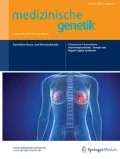Zusammenfassung
Die dynamische Entwicklung in der Sequenziertechnologie hat die technischen Kosten sowie die Zeit, die benötigt wird, ein individuelles Genom zu entschlüsseln, so dramatisch reduziert, dass die komplette Sequenzierung persönlicher Genome für Privatpersonen und Gesundheitssysteme finanzierbar wird. Die breite Verfügbarkeit individueller Genome wird die Medizin weiter in Richtung einer informationsbasierten Wissenschaft treiben und die Bedeutung der informationswissenschaftlichen Techniken erhöhen.
Abstract
Recent advances in sequencing technology have reduced the costs and time required to decode a single genome to the extent that complete sequencing of personal genomes becomes affordable for both private individuals and the health care system. The broad availability of individual genomes will drive medicine further towards an information-based science and the importance of IT solutions in medicine will increase.
Notes
Steven Brenner merkte skeptisch an, „that it remains to be seen whether we will learn anything more important from our genomes than the need to use suncream, eat better and exercise more“ [17].
Literatur
International Human Genome Sequencing Consortium (2004) Finishing the euchromatic sequence of the human genome. Nature 431: 931–945
Levy S et al (2007) The diploid genome sequence of an individual human. PLoS Biol 5:e254
Wheeler DA et al (2008) The complete genome of an individual by massively parallel DNA sequencing. Nature 452:872–876
Bentley DR et al (2008) Accurate whole human genome sequencing using reversible terminator chemistry. Nature 456:53–59
Wang J et al (2008) The diploid genome sequence of an Asian individual. Nature 456:60–65
Ahn SM et al (2009) The first Korean genome sequence and analysis: Full genome sequencing for a socio-ethnic group. Genome Res 19:1622–1629
Mardis ER (2008) Next-generation DNA sequencing methods. Annu Rev Genomics Hum Genet 9:387–402
Shendure J, Ji H (2008) Next-generation DNA sequencing. Nat Biotechnol 26:1135–1145
Gupta PK (2008) Single-molecule DNA sequencing technologies for future genomics research. Trends Biotechnol 26:602–611
Kaput J et al (2009) Planning the human variome project: the Spain report. Hum Mutat 30:496–510
Mallal S et al (2008) HLA-B*5701 screening for hypersensitivity to abacavir. N Engl J Med 358:568–579
Becquemont L (2008) Evidence for a pharmacogenetic adapted dose of oral anticoagulant in routine medical practice. Eur J Clin Pharmacol 64:953–960
Ley TJ et al (2008) DNA sequencing of a cytogenetically normal acute myeloid leukaemia genome. Nature 456:66–72
Altshuler D, Daly MJ, Lander ES (2008) Genetic mapping in human disease. Science 322:881–888
Lohmueller KE, Pearce CL, Pike M et al (2003) Meta-analysis of genetic association studies supports a contribution of common variants to susceptibility to common disease. Nat Genet 33:177–182
Palsdottir A et al (2008) A drastic reduction in the life span of cystatin C L68Q carriers due to life-style changes during the last two centuries. PLoS Genet 4:e1000099
Brenner SE (2007) Common sense for our genomes. Nature 449:783–784
Yoshiura K et al (2006) A SNP in the ABCC11 gene is the determinant of human earwax type. Nat Genet 38:324–330
Ng PC, Murray SS, Levy S, Venter JC (2009) An agenda for personalized medicine. Nature 461:724–726
Interessenkonflikt
Der korrespondierende Autor gibt an, dass kein Interessenkonflikt besteht.
Author information
Authors and Affiliations
Corresponding author
Rights and permissions
About this article
Cite this article
Krawitz, P. Personalisierte Medizin durch individuelle Genome. medgen 22, 248–253 (2010). https://doi.org/10.1007/s11825-010-0216-1
Published:
Issue Date:
DOI: https://doi.org/10.1007/s11825-010-0216-1

